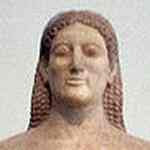A millenium of
style worn by one of the most important gods of antiquity.
 | This a bronze statue from 700 BCE. Allegedly one of the first depictions of Apollo. It is unclear if the god has actually some hair or some kind of cap or helm. probaby it is hair, but it doesn't seem to be an important distinctive sign. |
 | An early Kouros, the Anavysos Kouros. Many early depictions of Apollo as a young athletic man are likewise. The hair, a symbol of strenght in the Greek world, is now prominent. The Kouros has a head full of hair, and long locks descending on the shoulders. |
 | The Apollo of Veii. An Etruscan statue dating from the sixth century BCE. The influence of the contemporary Greek style is evident. |
 | The Apollo from the Temple of Zeus in Olympia (460 BCE). The hairstyle is more restrained, the long locks are gone. Yet the hair is full, curly. The young god is in his prime, full of strenght. |
 | An example of an Apollo of Mantua type. A Roman copy of a greek bronze statue probably from the fifth century BCE. The hairstyle is completely reminiscent of the early kouros |
 | This is the Barberini Apollo in the Glyptotek in Munich. It is, again, a Roman copy of a Greek statue from the third century. The hairstyle is halfway between the kourous hairstyle and the Belvedere Apollo hairstyle. I've always found this particular statue very effeminate in its appearance |
 | The Choisier Gouffier Apollo. A Roman copy of a greek bronze statue probably contemporary with the Olympia Apollo. The hairstyle is strikingly similar. |
 | The classic Belvedere Apollo from the Capitoline Museums in Rome. A Roman copy of a greek bronze statue probably from the fourth century BCE. The hairstyle is different. Long curly hair with tied locks on top of the head. |
 | This is the Apollo Citharedous of the Vatican Museums. A Roman statue from the Second Century, it is full of citation from earlier greek examples. This Apollo sports a head full of curly hair with the addition of a laurel crown, another typical attribute of Apollo as a god of Music and the Arts in general. |
 | The Apollo Sauroctonos. A Roman copy of a statue by Praxiteles (IV Century BCE). This is Apollo as hunter, as killer of lizards and pythons. The hair is shorter, and tied with a string |
 | Possibily a bronze Praxiteles original. Again, note the similarities in the hairstyle |
 | The Lycian Apollo. Another Roman copy of a Praxitels original. This is a snake-slayer Apollo, and the again the shorter hair shows it. The locks on top of the forehead are similar to the Belvedere Apollo, though. |
 | A late roman mosaic depicting Apollo as Phoebus, the sun god. Still a head full of hair, but in addition, the god has an aureole. It's not something particularly surprising, it had been an attribute of Apollo for centuries, predating the traditional depiction of Christian Saints and Angels |
 | This is not Apollo at all, but a fourth century A.D. depiction of Somebody else. Note the similarities with the other Apollos, anyway. |
Oh, and by the way, my nickname is not directly related to Apollo... It's part of an anagram of my real name I used on a very old Linux machine a decade ago, and it's also an hommage to ...
Elio (i.e. Helios, the Sun), one of my favourite singers
that's great.
ReplyDeleteI love you for doing this. Really interesting.
ReplyDelete